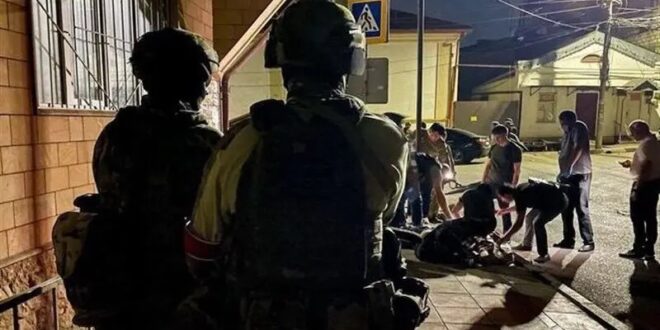Details are still emerging about the June 23 violence in Russia’s North Caucasus region of Daghestan.
At least 20 people were killed, including 15 police officers, according to Russia’s Investigative Committee, when gunmen attacked a synagogue, two Russian Orthodox churches, and police targets in the regional capital, Makhachkala, and the city of Derbent, some 120 kilometers to the south. Five gunmen were reportedly killed, while 16 people — including 13 police officers — were reportedly injured.
There was no immediate claim of responsibility.
The incident came in the context of Daghestan’s decades-long simmering unrest, with fuel thrown on the fire by Russia’s war against Ukraine.
Vilayat Kavkaz
The Russian authorities have not released the names of the five slain gunmen. However, Caucasus-related Telegram channels have identified two of them as sons of Magomed Omarov, a local district head and ruling United Russia party official who was promptly expelled over the incident. Another of the killed attackers was said to have been Omarov’s nephew. Omarov has reportedly been detained on suspicion of abetting terrorism.
The Telegram channel Baza, which has ties to law enforcement, claimed that Omarov said under questioning that he knew his sons and nephew were extremists and had not been in contact with them “for the last few years.” There was no way of verifying that account or a report by the Telegram channel Mash that one of the sons, Osman Omarov, had returned in April from spending 18 months in Turkey
The U.S.-based Institute for the Study of War (ISW) wrote on June 23 that the attack may have been coordinated by the North Caucasus branch of the extremist group Islamic State, which is known as Vilayat Kavkaz. A media channel tied to a broader regional IS affiliate issued a statement praising their “brothers from the Caucasus,” which ISW analysts interpreted as a strong indication that Vilayat Kavkaz had carried out the attack.
Russia’s counterterrorism agencies have been cracking down on people they claim are members of Vilayat Kavkaz since the March 22 attack on the Crocus City Hall concert venue outside Moscow that killed 145 people and was claimed by IS, though most of the suspects in that attack were Tajiks and there was no known connection to the North Caucasus.
Accusing Ukraine And The West
Without providing evidence, several Russian officials quickly placed responsibility for the attacks on Ukraine and NATO, just as they did after the Crocus City Hall attack.
“Today we find ourselves participants in those events that are happening around the world,” Daghestan head Sergei Melikov said on June 24, seemingly seeking to lay blame outside his region and outside Russia. “We must understand that war has come to our house.”
Magomed Gadzhiyev, a member of Russia’s lower parliament house from Daghestan, claimed without evidence that the attacks were “in one way or another tied to the secret services of Ukraine and NATO countries.” They were, he added, an “attempt to destabilize the situation in our country” against the backdrop of “the successes of our forces” in Ukraine.
Dmitry Rogozin, prominent former diplomat and a member of the upper parliament house, cautioned against such conclusions, saying that blaming NATO for every such incident could prevent Russia from identifying internal threats and “lead to big problems.”
Likewise, a North Caucasus analyst who asked not to be named out of security concerns for speaking to RFE/RL said that Russia should seek the root causes of the radicalization of youths in Daghestan.
“They need to figure out what motivates them, rather than trying to hush up the incident by citing ‘the influence of Ukraine or the West,’” the analyst told RFE/RL’s Caucasus.Realities.
Simmering Discontent
Daghestan, with a population of more than 3.1 million, is the largest region of Russia’s North Caucasus. It is one of the most ethnically and linguistically diverse areas in the world, a mountainous patchwork with 14 official languages and a dozen major ethnic groups. More than 80 percent of the population is Sunni Muslim. There is a significant conservative Salafi minority that has long been accused of extremism by the Russian authorities and targeted for repression.
One of Russia’s poorest and least-developed regions, Daghestan regularly reports one of the highest unemployment rates in the country. It played a role in the wars in neighboring Chechnya in the 1990s and 2000s and was embroiled in an Islamist insurgency in the North Caucasus that stemmed from those conflicts.
The June 23 violence was the first major incident of its type in the region in about 15 years. However, unrest has been on the increase since Russia’s full-scale invasion of Ukraine in February 2022. Daghestan is one of a number of impoverished, non-ethnic-Russian regions that has disproportionately contributed troops to the war.
After President Vladimir Putin announced a massive military call-up in September 2022 amid battlefield setbacks in Ukraine, Daghestan became a locus of anti-mobilization protests.
Separately, in October 2023, a mob of more than 1,000 people shouting anti-Semitic slogans stormed the airport in Makhachkala amid inflammatory social media reports that the region was accepting Israeli refugees from the Gaza War. Russian officials sought to blame the West for that violence as well.
As has been the case across Russia since the Ukraine invasion, analysts say, security forces in Daghestan have been primarily occupied with suppressing dissent over the war, compounding anger among restive citizens and leaving the country more vulnerable to potential extremist attacks.
 Eurasia Press & News
Eurasia Press & News



